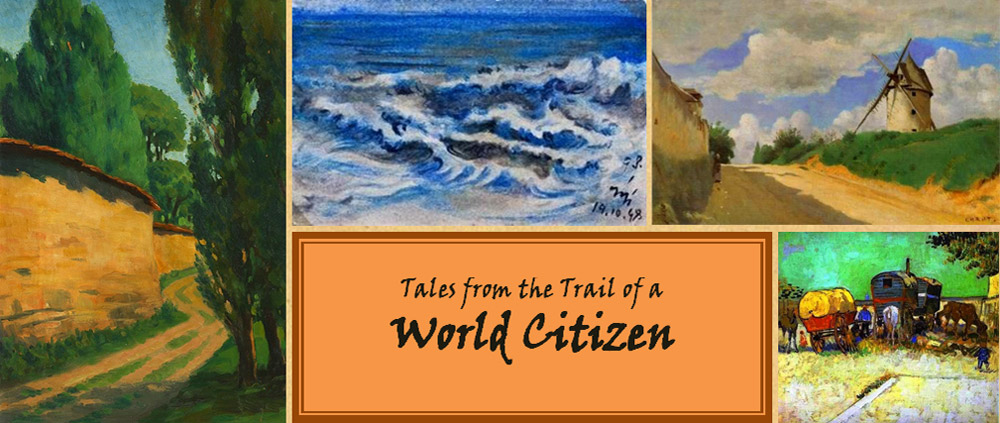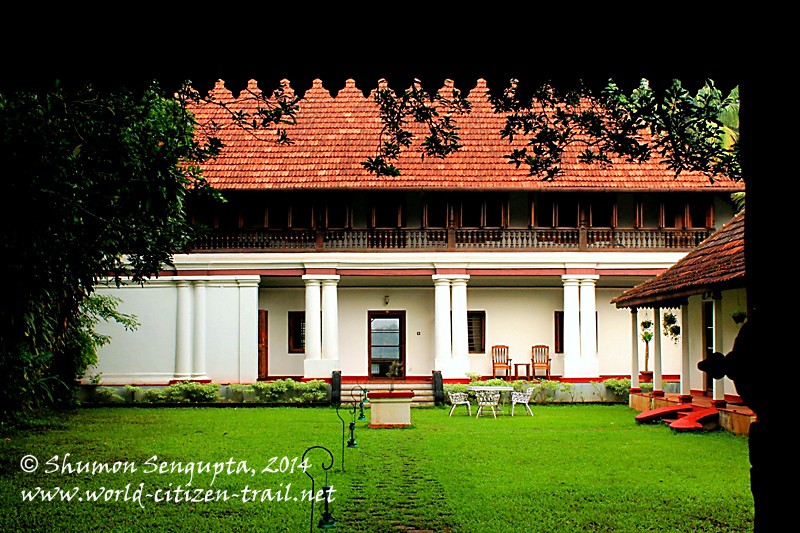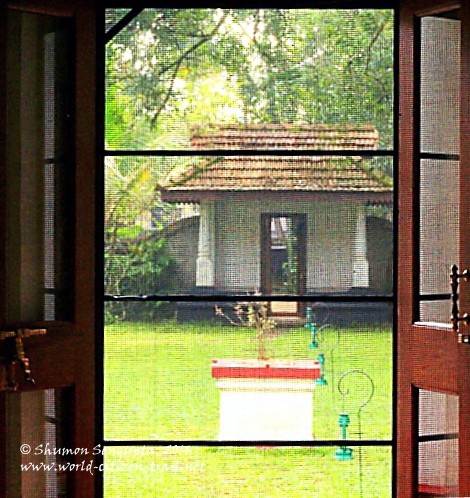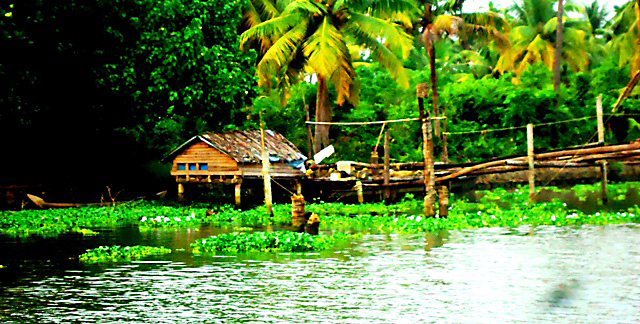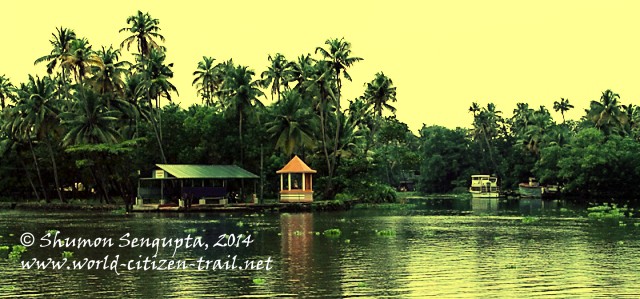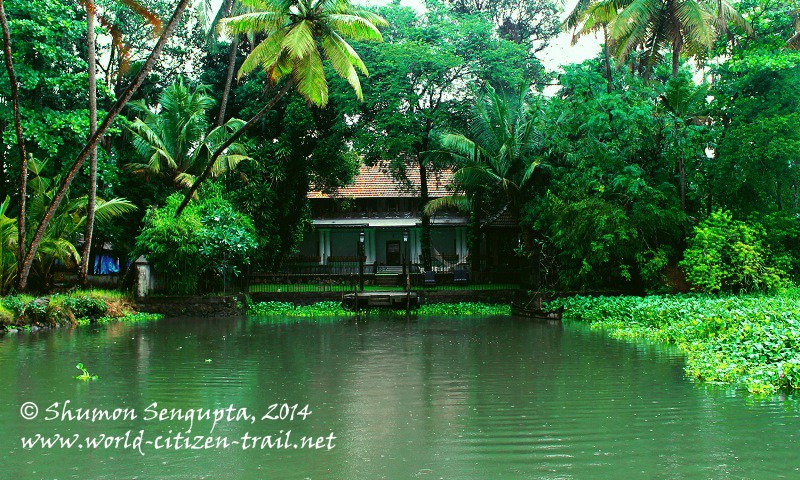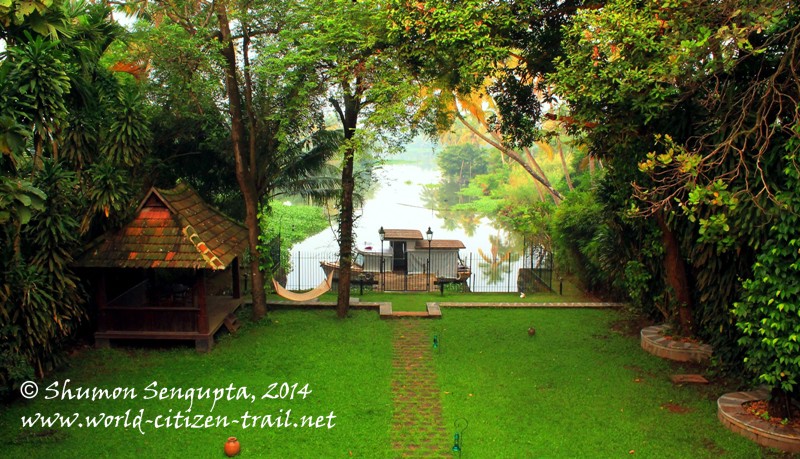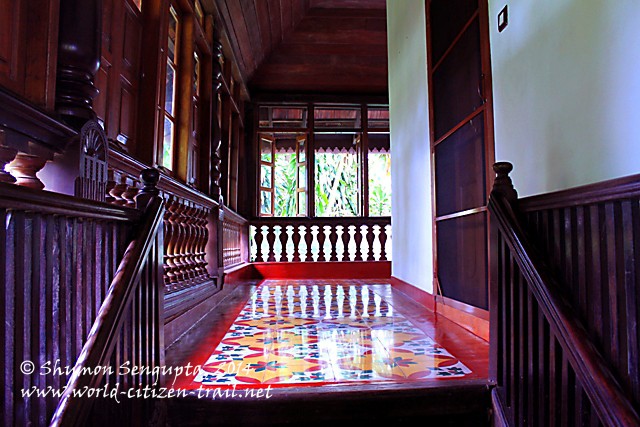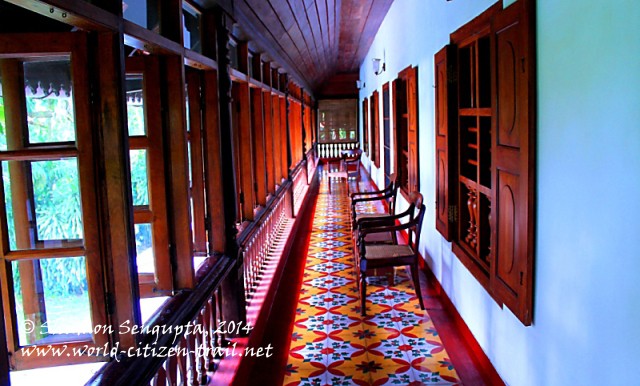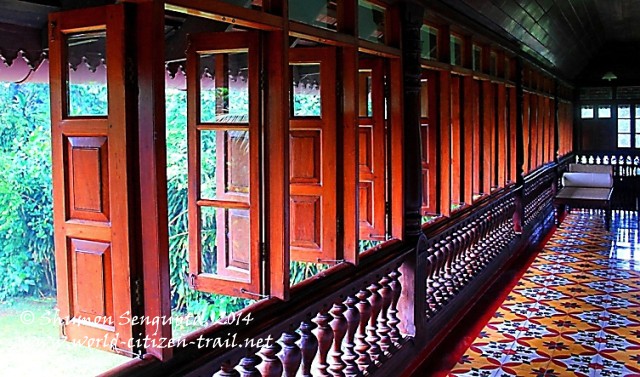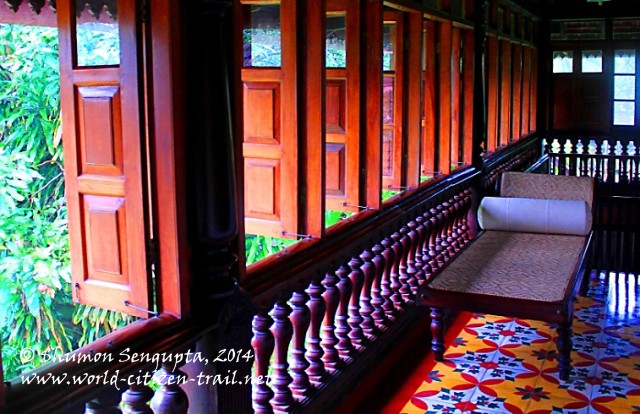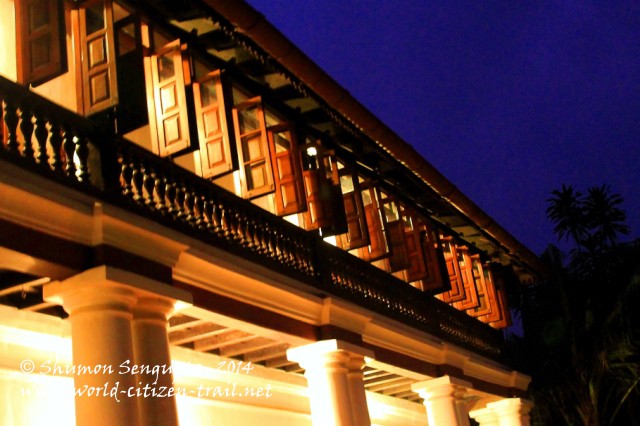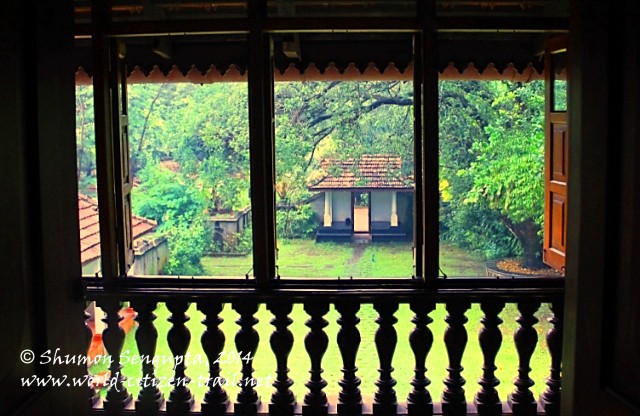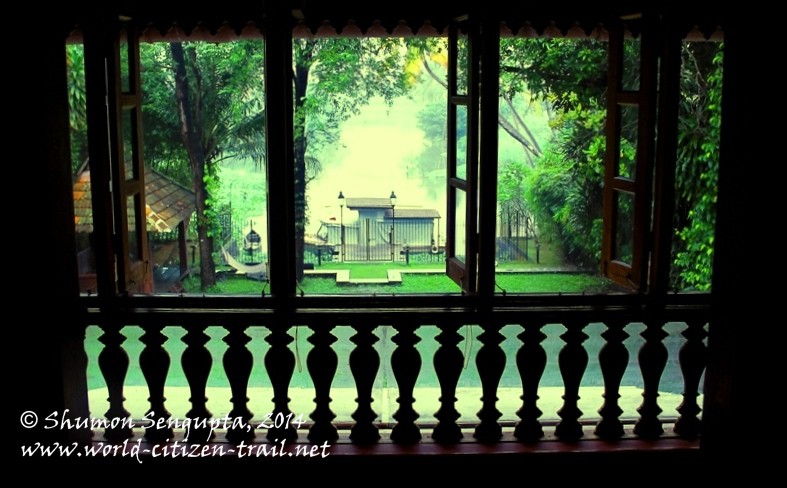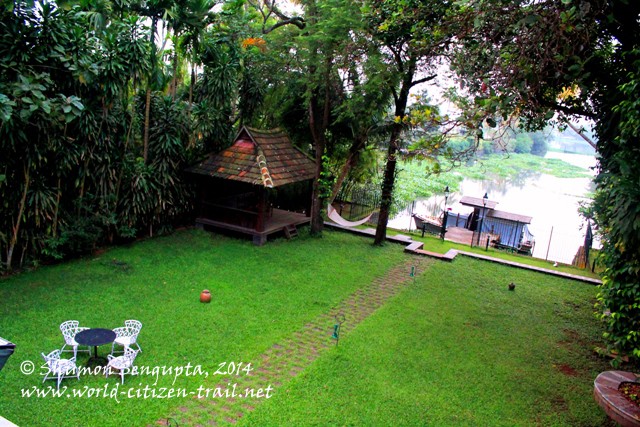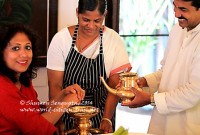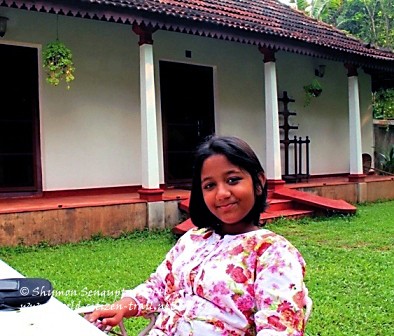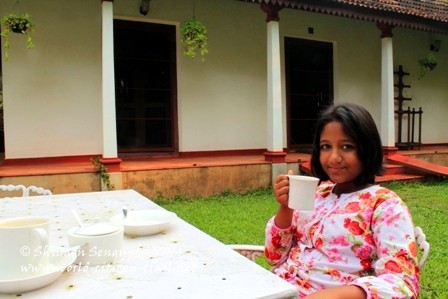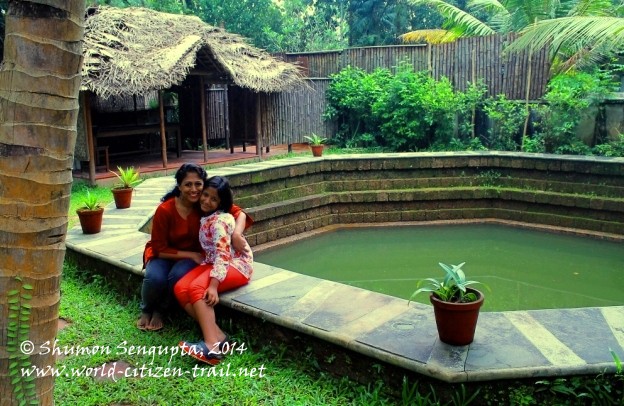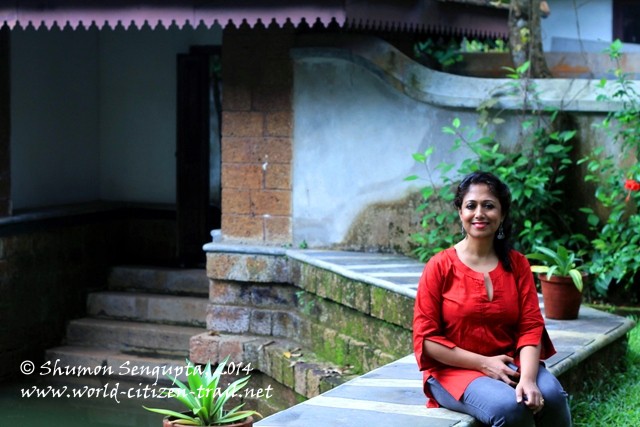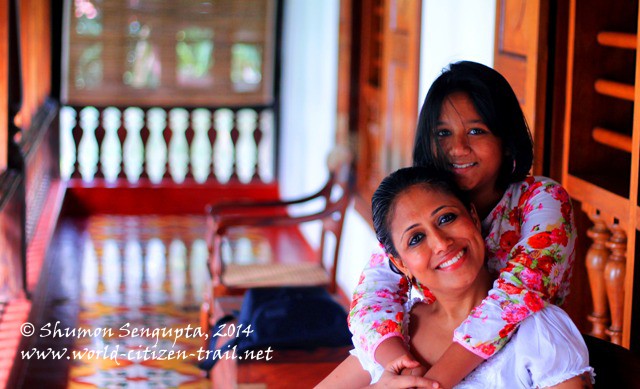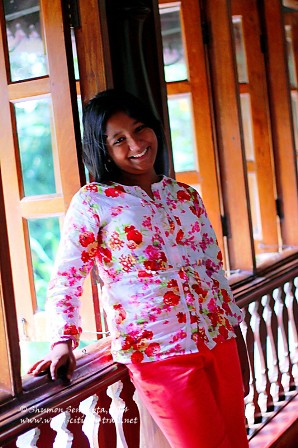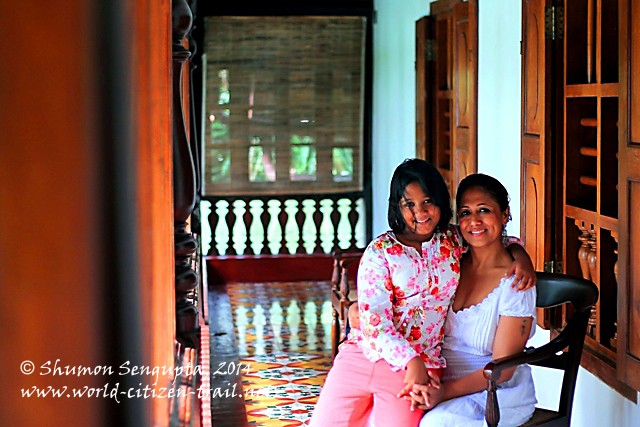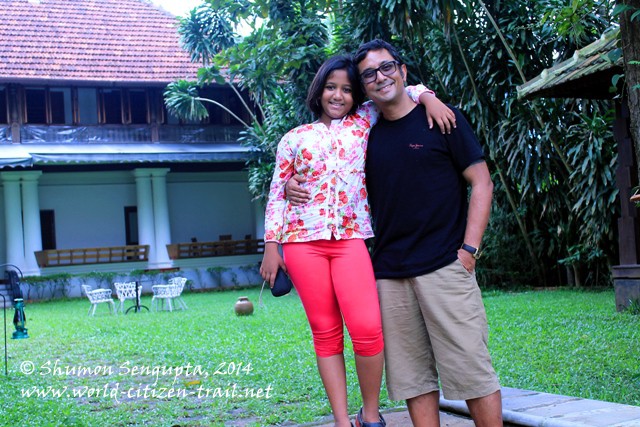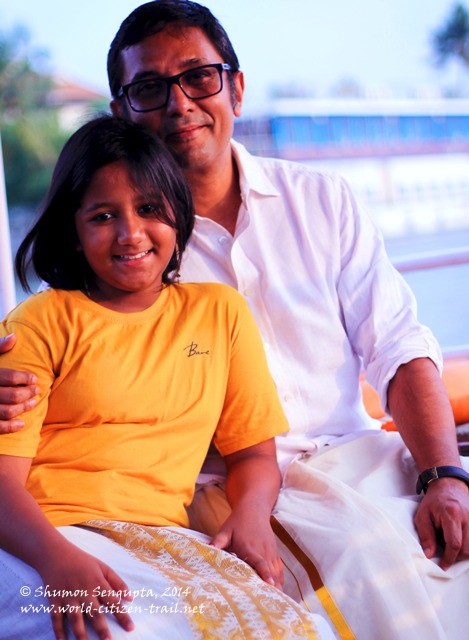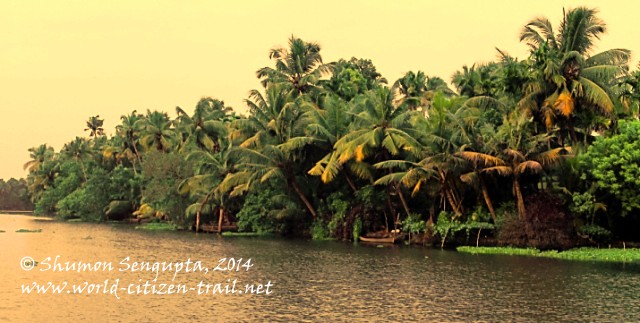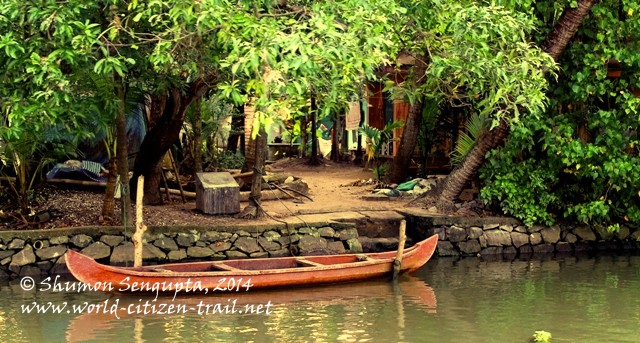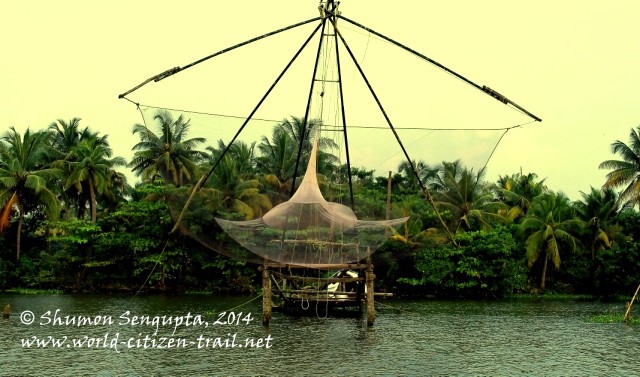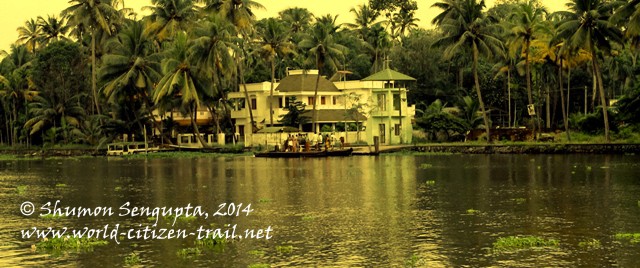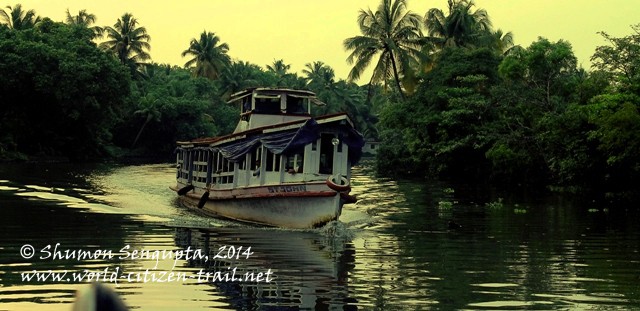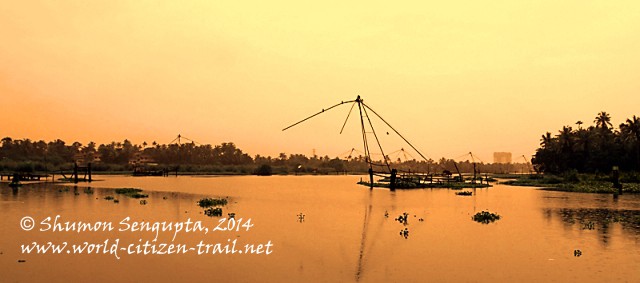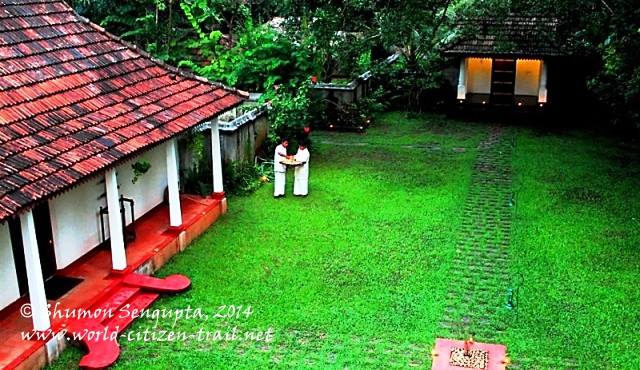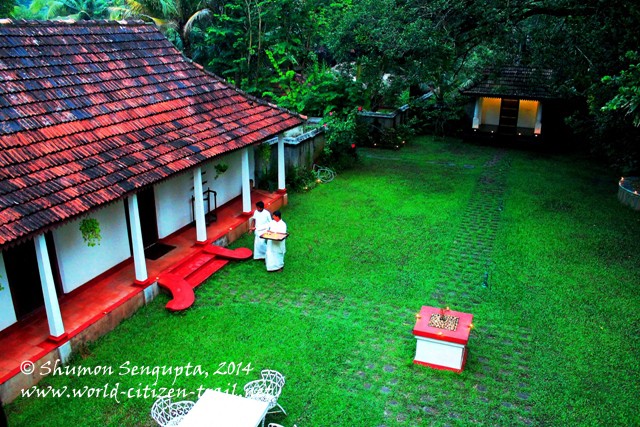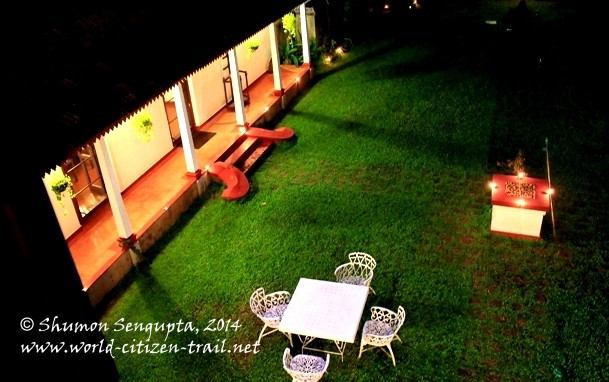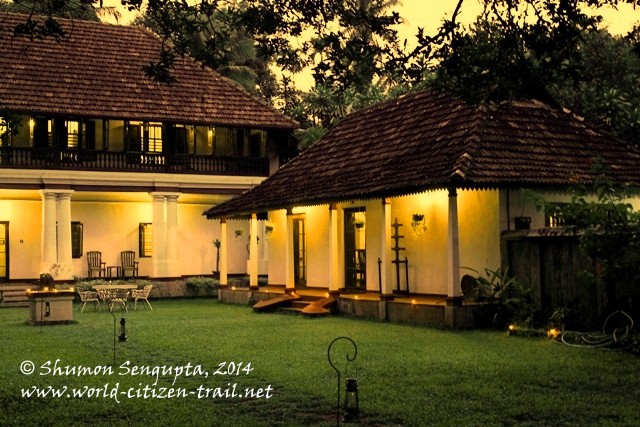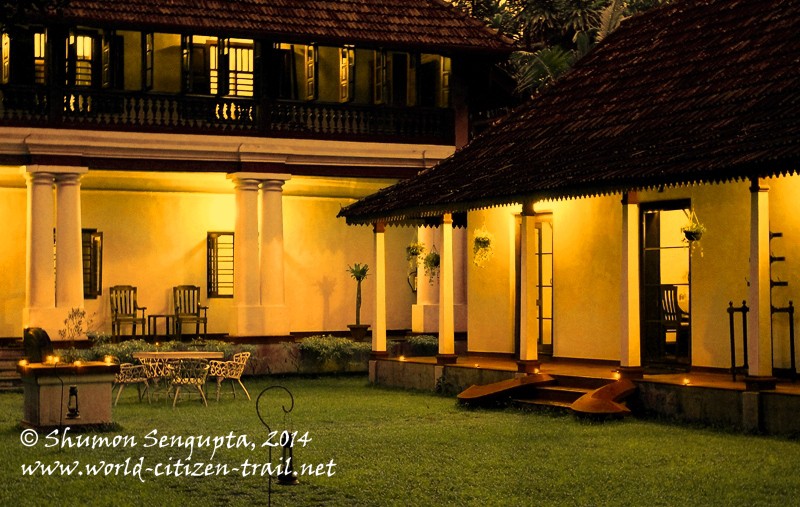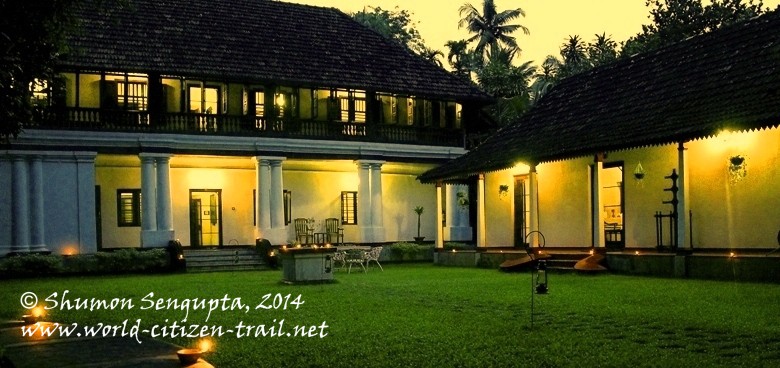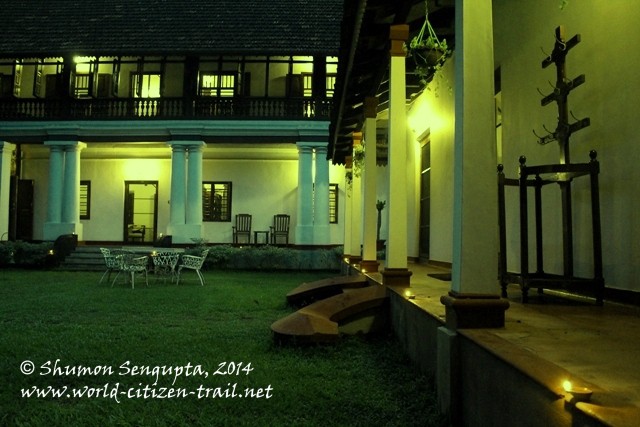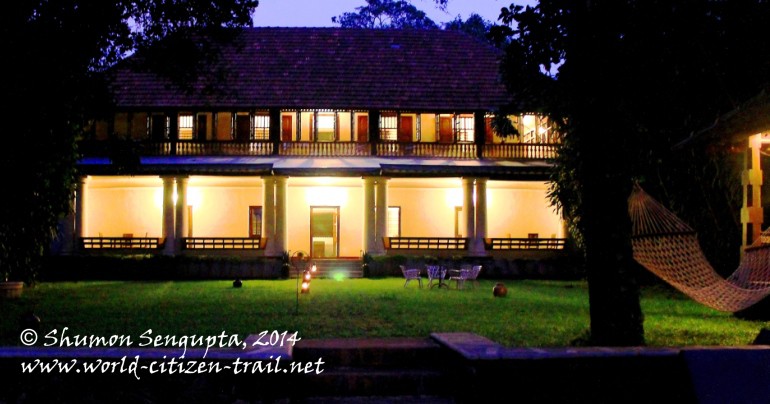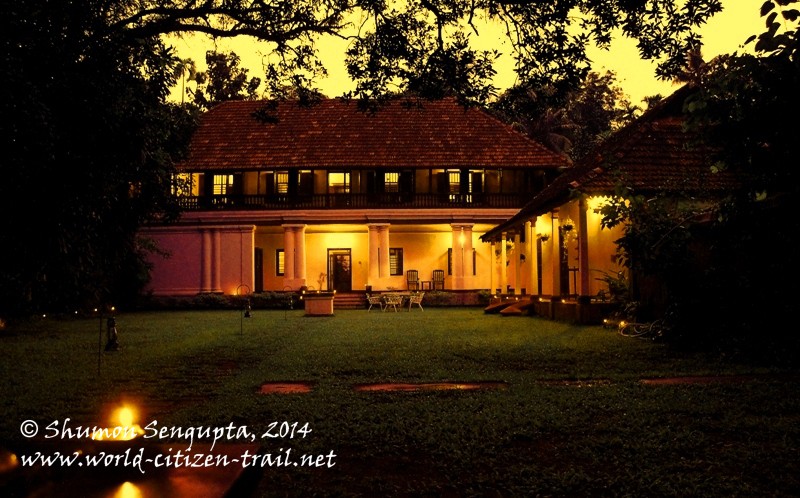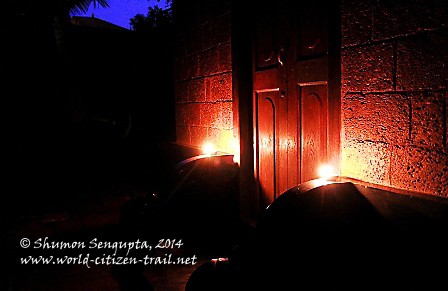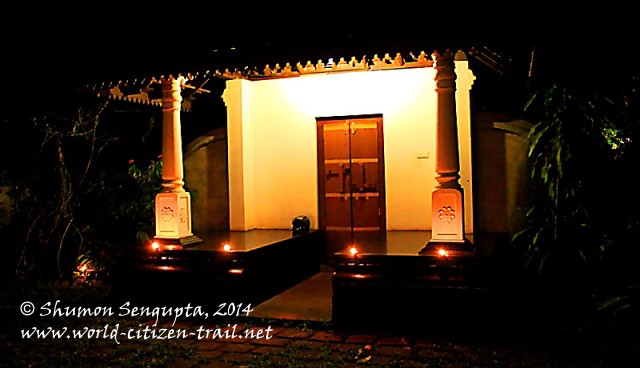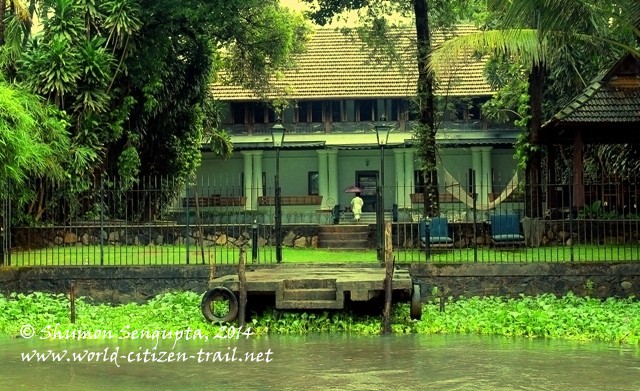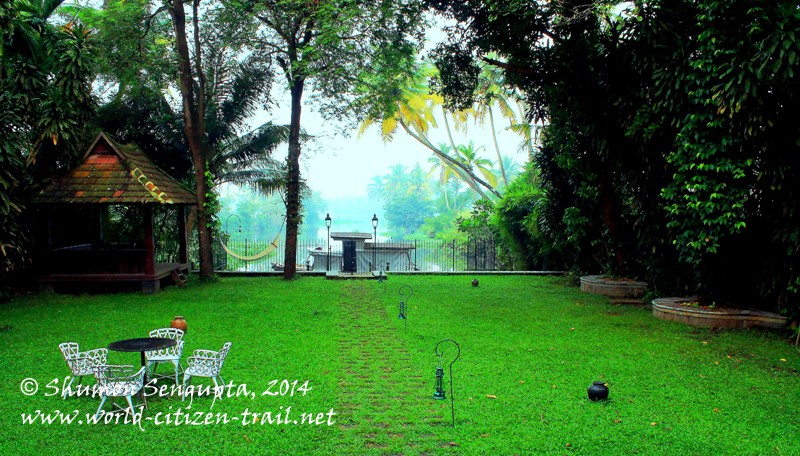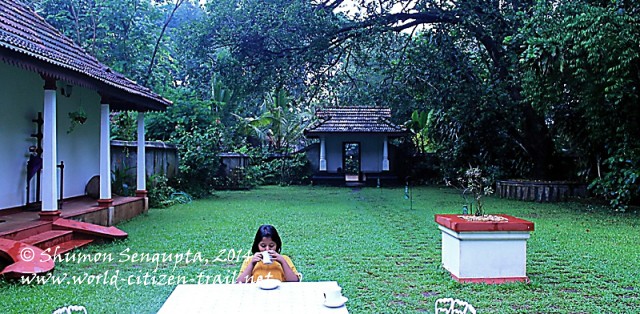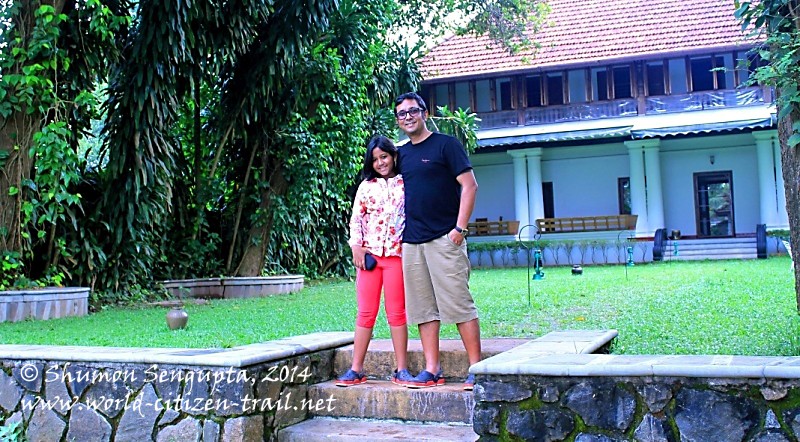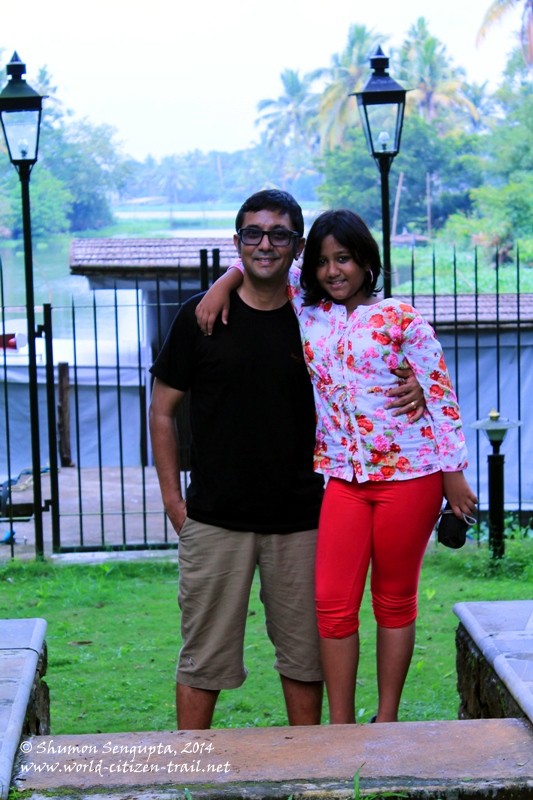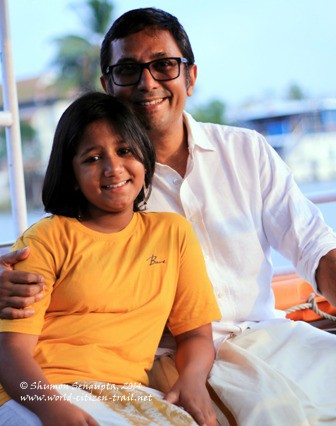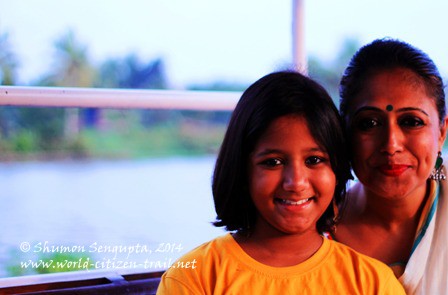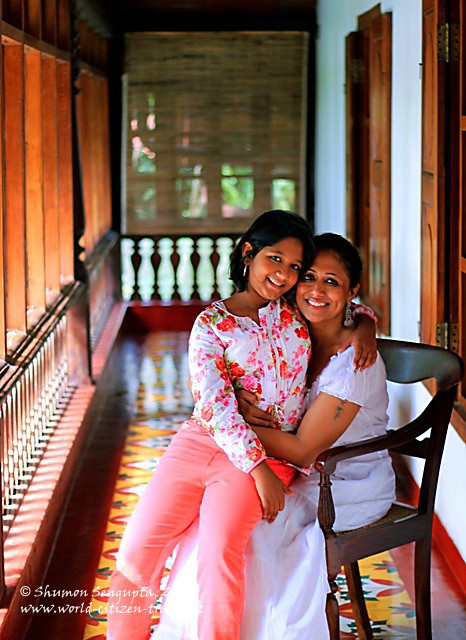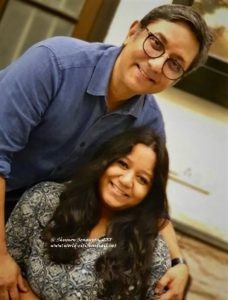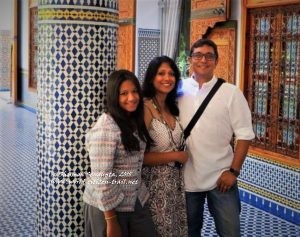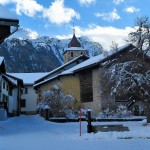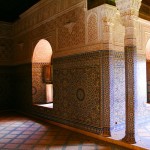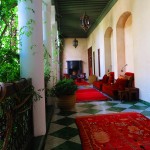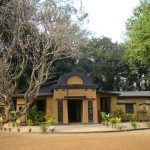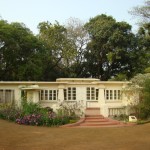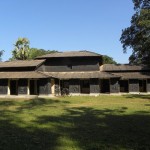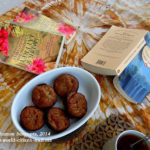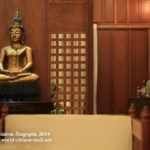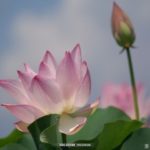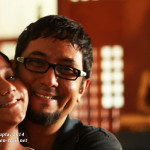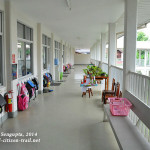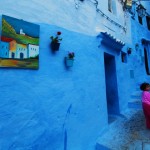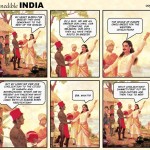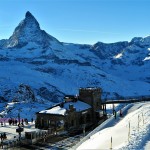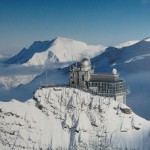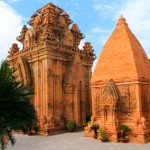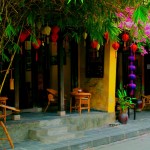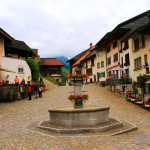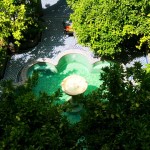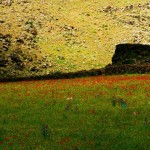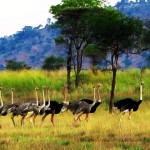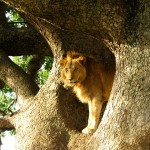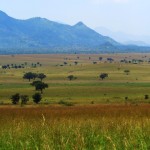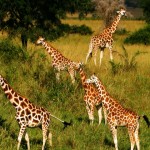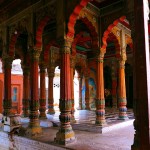************************************************
Placid waters beneath with drifting hyacinth, azure blue skies high above with birds in flight and a beautiful little palace peeping out from the dense tropical vegetation in the middle – all taken together left us totally spell bound.
In the mornings we woke up to the sound of distant temple bells and the birdcall and then took the day as it presented itself. The afternoons were incredibly beautiful; spent under the trees in solitude, with birdcalls and the rustle and murmur of leaves for music.
And then everything was bathed in molten silver of the late afternoon sun, filtered through scattered monsoon clouds. In the evenings with the golden glow of the setting sun, came the sounds of temple bells. From afar, came floating the faint sound of the Azan – the melodious call for Muslim prayers. Numerous earthen lamps studded the tropical night with the soft warm glow of their dancing flames, setting into action the play of a thousand mysterious shadows.
If one could live in magic, it was right there….
************************************************* 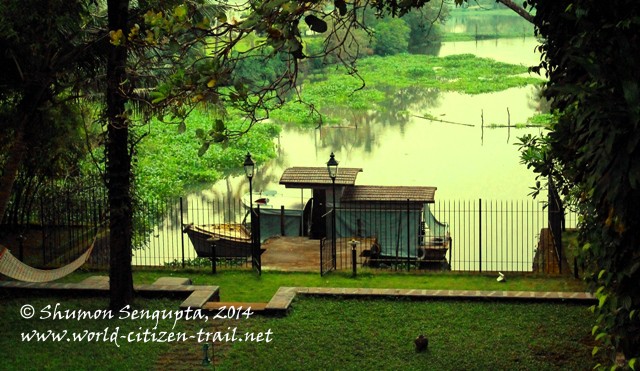
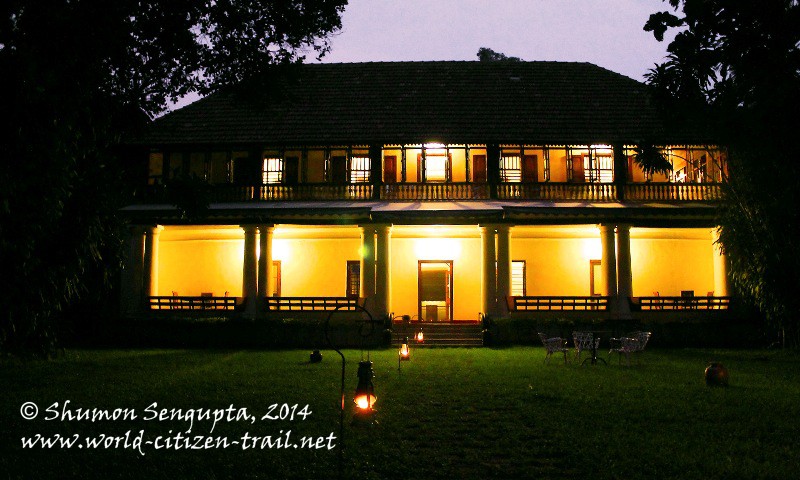
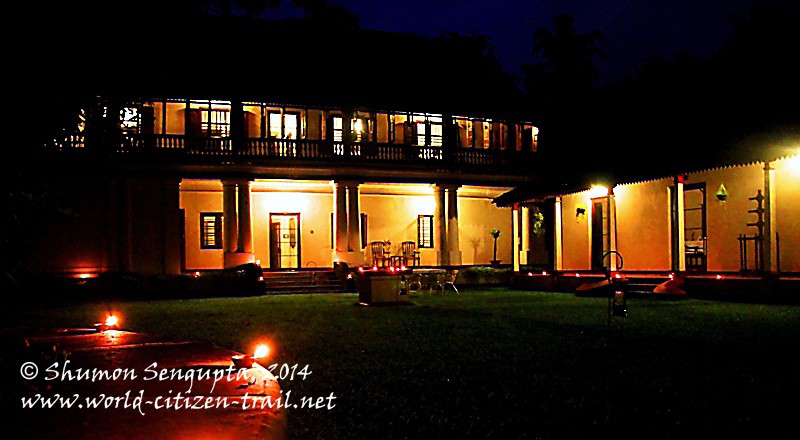
****************************************************
Chittoor Kottaram is located in a beautiful, small, lush green and quite island hamlet called Cheranelloor in the Periyar estuary, surrounded by wetlands, lagoons, backwaters and canals. You can access the property either through a bridge or in a boat from mainland Ernakulam.
To take the water route, you will have to board the private little launch of Chitoor Kottaram at the Varapuzha Jetty in Ernakulam. A cruise over the Periyar estuary along busy water traffic that includes ferries, launches, boats, ships etc will eventually take you to the quieter part of the estuary along little islands, quant villages, churches, temples and giant spider-web like Chinese-style fishing nets. Finally, from the estuary, you will take a turn to a short private canal and the beautiful little palace will suddenly emerge ahead of you, amidst dense vegetation.
Placid waters beneath with drifting hyacinth, azure blue skies high above with birds in flight and a beautiful little palace peeping out from the dense tropical vegetation in the middle – all taken together are sure to take your breath away.
From the small private jetty, which serves as the western entrance to the palace, you step up into the back garden of the palace. To the immediate right is a small elevated gazebo made of wood, which also doubles as a small open air tea room. This is an ideal place to relax and read a book, while having your tea and next to it is a hammock .

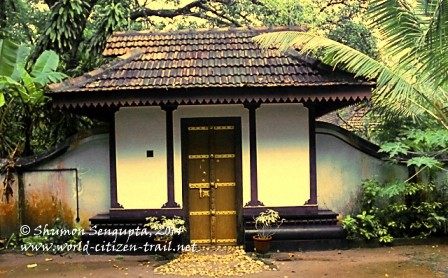 If you take the land route to Chittoor Kottaram, you will go past a temple and arrive at the property through its eastern entrance. You will enter through a charming little arched gateway (the Padippura), built in the traditional Kerala style.
If you take the land route to Chittoor Kottaram, you will go past a temple and arrive at the property through its eastern entrance. You will enter through a charming little arched gateway (the Padippura), built in the traditional Kerala style.
Since we were travelling from Thrishur, we took the land route and crossed over to the island through the bridge, which is a fairly recent construction. It was on our second evening at the end of a sunset cruise of the Periyar estuary that we experienced what it would be to check in, using the water route.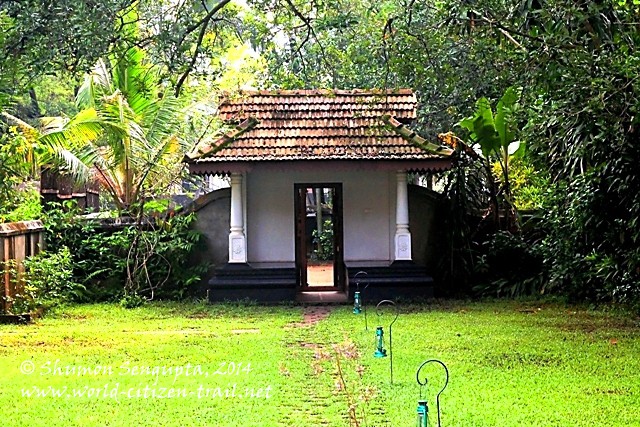
The second monsoon in Kerala (October-November) was already on; the sky was partially overcast, everything around us was fresh, green, sparkling and pristine and the breeze was cool and moist. As we entered through the gateway into the sprawling green lawn fringed by lush green trees, we were transported back into a distant time. The place seemed to be engulfed in a mysterious time warp – profoundly peaceful and tranquil.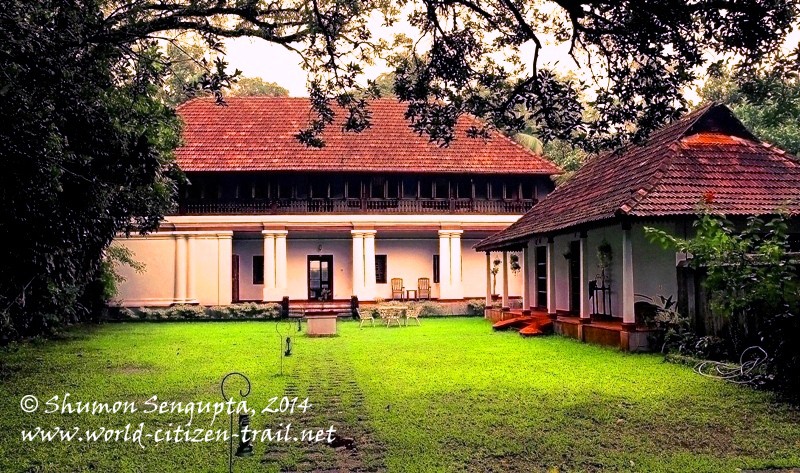 Crossing over the threshold of the property, we found a small reception team eagerly waiting for us. We were received by Annie, Milton, Jitin and Junaid in the traditional ritual manner, with small fragrant garlands, incense, a lit oil lamp and flowers. Our foreheads were marked with sandal wood paste and we were escorted along with the token palm-frond umbrella.
Crossing over the threshold of the property, we found a small reception team eagerly waiting for us. We were received by Annie, Milton, Jitin and Junaid in the traditional ritual manner, with small fragrant garlands, incense, a lit oil lamp and flowers. Our foreheads were marked with sandal wood paste and we were escorted along with the token palm-frond umbrella. 

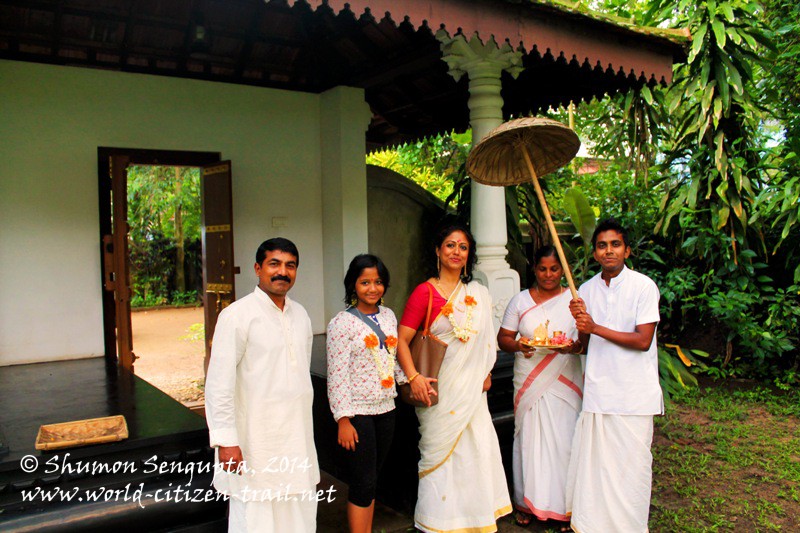
 Now those of you who are not familiar with elements of Hindu culture may like to know that this beautiful reception ritual is meant to drive away evil spirits, invest positive energy and invoke the divinity that Hindus believe resides within every human being – the guest in this case. By thus honoring the guest, the ritual also gives expression to the traditional Indian credo of hospitality – Athithi Devo Bhava or “Guest is a deity”.
Now those of you who are not familiar with elements of Hindu culture may like to know that this beautiful reception ritual is meant to drive away evil spirits, invest positive energy and invoke the divinity that Hindus believe resides within every human being – the guest in this case. By thus honoring the guest, the ritual also gives expression to the traditional Indian credo of hospitality – Athithi Devo Bhava or “Guest is a deity”.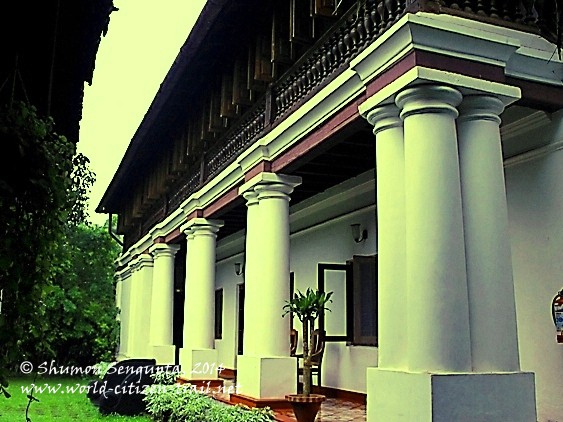
The mini palace of Chittoor Kottaram, said to be over two hundred years old, is a single-key hotel in that the entire property is given out exclusively to just one family at a time and a maximum of 6 family members can stay at any given point in time. The living space spread over two floors, dining area, the lush green gardens and lawns, the little octagonal tank and the thatched massage area, the little boat jetty with the launch are all at your sole disposal during your stay. The explicit theme of this property is to treat guests as royalty and provide personalized service, as it was, to the Kochi royals in the past.
Milton escorted us through the cobbled path over the western lawn and informed us with a grand flourish that we were the “King, Queen and Princess” – (or the Thampuran, Thampurati et al) of the palace. Milton also told us in a deferential tone that our “attendants” would be at “our beck and call” and since it was to be our “exclusive domain” while we were there, no one else would be allowed entry into the premises without our “explicit permission”, just as it was during the days of the royalty! We loved the role play and quickly got into our roles, which made Milton happy.
Ahead of us, in the middle of the garden was the magnificent white, deep brown and rust red façade of Chittoor Kottaram. It was the place where we were to spend two days and two nights, pretending to be royals. Facing the little palace, to our right was a small pavilion with tall sloping red tiled roof. This pavilion housed the dining hall, kitchen and pantry and had nice little verandas on three sides.

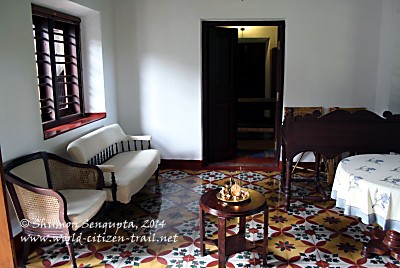 Managed by the CHG Earth Group of Hotels, Chittoor Kottaram, in its time, was a spiritual retreat for the Kochi Maharajah and is still considered as a sacred space. So we had to take off our footwear before entering the building and remain that way, just as the Maharajah did in his days.
Managed by the CHG Earth Group of Hotels, Chittoor Kottaram, in its time, was a spiritual retreat for the Kochi Maharajah and is still considered as a sacred space. So we had to take off our footwear before entering the building and remain that way, just as the Maharajah did in his days.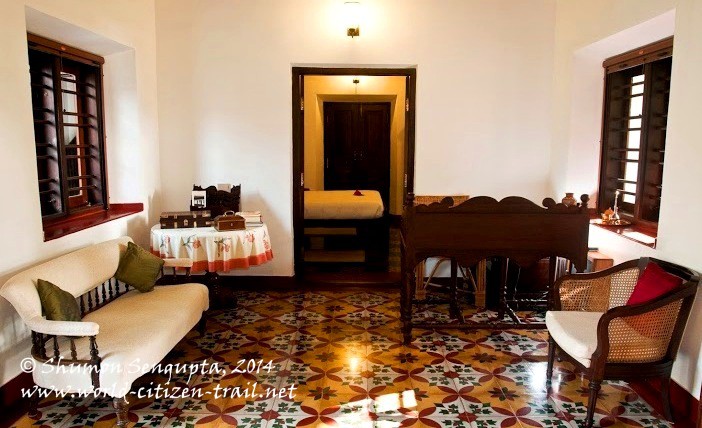
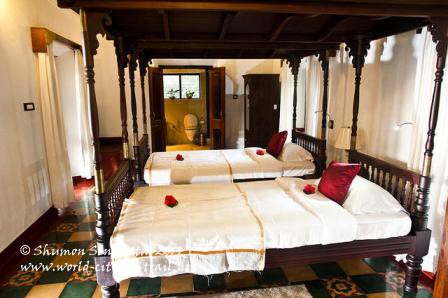

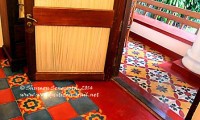 On the ground floor, there are two large bedrooms with attached bathrooms. Between these two bedrooms is a small parlor. The floors are paved with colorful hand painted tiles and there are heavily colonnaded verandas on eastern and western sides.
On the ground floor, there are two large bedrooms with attached bathrooms. Between these two bedrooms is a small parlor. The floors are paved with colorful hand painted tiles and there are heavily colonnaded verandas on eastern and western sides. 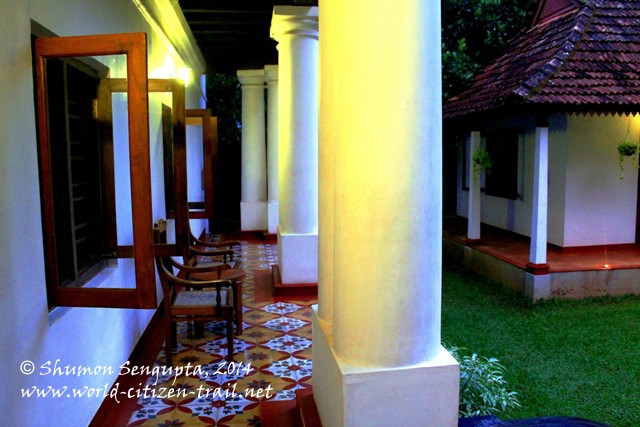
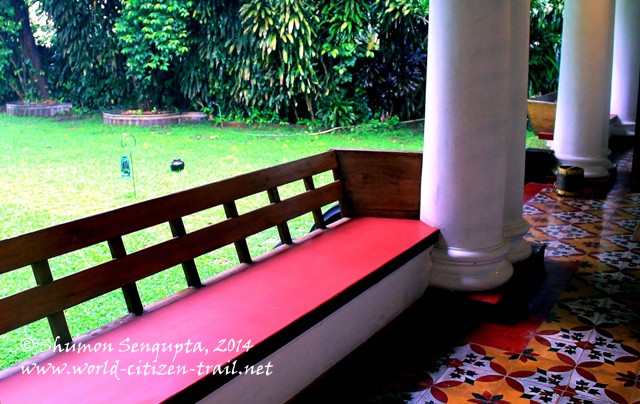
 The western veranda offers a splendid view of the canal and the Periyar estuary beyond and the eastern side affords a view of the beautiful front garden, the entry gate and the dining pavilion to the left.
The western veranda offers a splendid view of the canal and the Periyar estuary beyond and the eastern side affords a view of the beautiful front garden, the entry gate and the dining pavilion to the left.
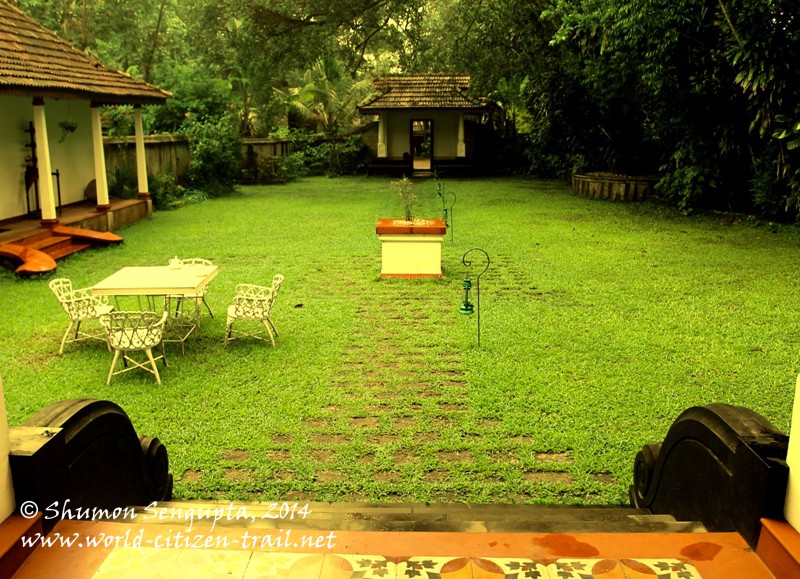
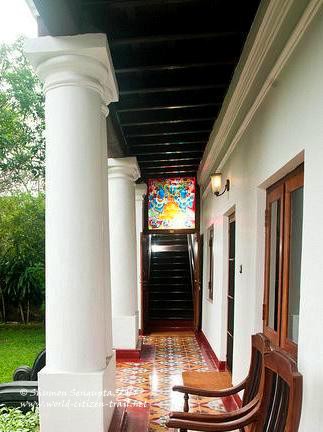
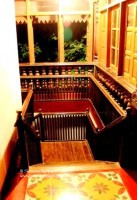
A flight of wooden stairs and a beautiful wooden balustrade lead from one side of the eastern veranda on the ground floor, to the upper floor. While the super structure has masonry walls and columns, the upper floor has extensive wood work, including an amazing wooden ceiling and a stunningly beautiful wooden wrap-around porch (or balcony) on four sides. The porch also has hand painted floor tiles.
On the upper floor there is a spacious private parlor with a wooden swing – big enough to be slept on. Next to the parlor is a sprawling bedroom – the master bedroom if you like, with an attached bathroom.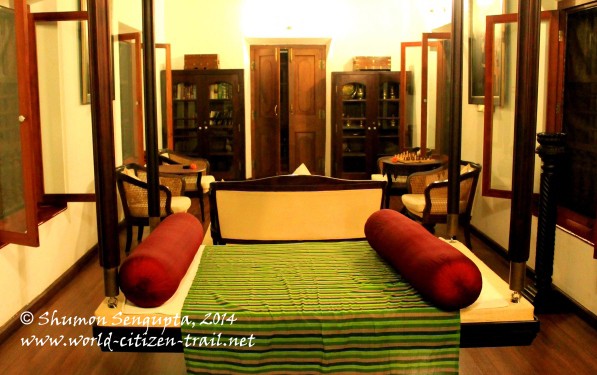
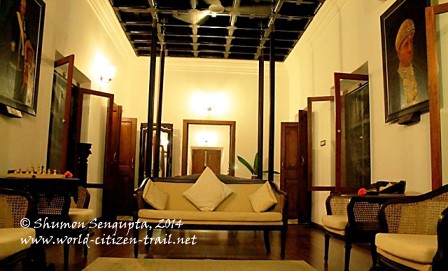
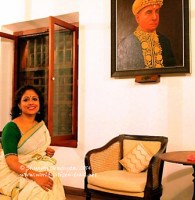 Furniture is made of polished teak and rosewood – beautiful, solid and grand, but without the flamboyance and opulence that one would generally associate with a royal palace. It includes stately solid wood four poster beds, quaint, charming wood and wicker chairs and sofas, center tables, side tables and writing desks. The swing is particularly impressive, for it does not hang from chains. Instead it hangs from four sleek, finely finished and polished teak wood poles suspended from the ceiling. Few walls have large portraits (oils) of the Kochi maharajas with somber looks. Everything is indicative of a highly cultivated taste, bereft of excessive ornamentation or any form of ostentation.
Furniture is made of polished teak and rosewood – beautiful, solid and grand, but without the flamboyance and opulence that one would generally associate with a royal palace. It includes stately solid wood four poster beds, quaint, charming wood and wicker chairs and sofas, center tables, side tables and writing desks. The swing is particularly impressive, for it does not hang from chains. Instead it hangs from four sleek, finely finished and polished teak wood poles suspended from the ceiling. Few walls have large portraits (oils) of the Kochi maharajas with somber looks. Everything is indicative of a highly cultivated taste, bereft of excessive ornamentation or any form of ostentation.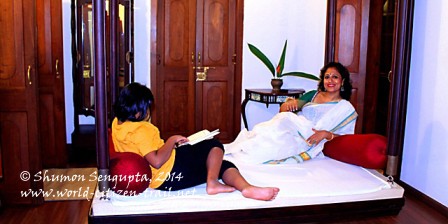 The modern bathrooms (later day improvements) come with their book cases stacked with an eclectic selection of books. The bathroom attached to the master bedroom on the top floor also has a skylight to enable natural light to come through during the day. The soft furnishings as well as towels in the bathrooms are simple and elegant – white cotton and linen, reflecting a discerning taste and a level of refinement rarely found these days. Recycled paper is used in most cases and plastics totally avoided.
The modern bathrooms (later day improvements) come with their book cases stacked with an eclectic selection of books. The bathroom attached to the master bedroom on the top floor also has a skylight to enable natural light to come through during the day. The soft furnishings as well as towels in the bathrooms are simple and elegant – white cotton and linen, reflecting a discerning taste and a level of refinement rarely found these days. Recycled paper is used in most cases and plastics totally avoided.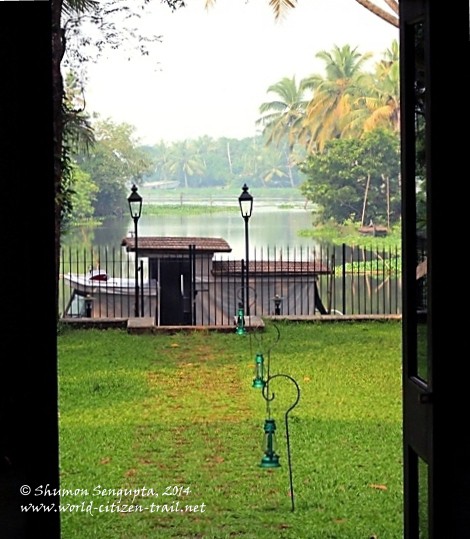 Bisecting the garden runs a cobbled pathway, lined by beautiful, simple low hanging lanterns. Next to main entry gate, to the right is a narrow path that leads to a charming little octagonal bathing tank (the Kulam) – where the Maharaja in his day, took his ritual bath before his daily prayers and worship. Neatly lined with moss laden red lateritic stone blocks, the tank has a traditional tiled portico (the the Kulappura) with a wooden door that opens directly on a short flight of stone steps, descending into the water. The tank is no longer used for bathing, but presents a very charming and quant sight. By the side of the octagonal tank is the little center for Kerala ayurvedic massage. It is a semi enclosed space made of wood, bamboo and thatch and attached to it an open air but private shower.
Bisecting the garden runs a cobbled pathway, lined by beautiful, simple low hanging lanterns. Next to main entry gate, to the right is a narrow path that leads to a charming little octagonal bathing tank (the Kulam) – where the Maharaja in his day, took his ritual bath before his daily prayers and worship. Neatly lined with moss laden red lateritic stone blocks, the tank has a traditional tiled portico (the the Kulappura) with a wooden door that opens directly on a short flight of stone steps, descending into the water. The tank is no longer used for bathing, but presents a very charming and quant sight. By the side of the octagonal tank is the little center for Kerala ayurvedic massage. It is a semi enclosed space made of wood, bamboo and thatch and attached to it an open air but private shower.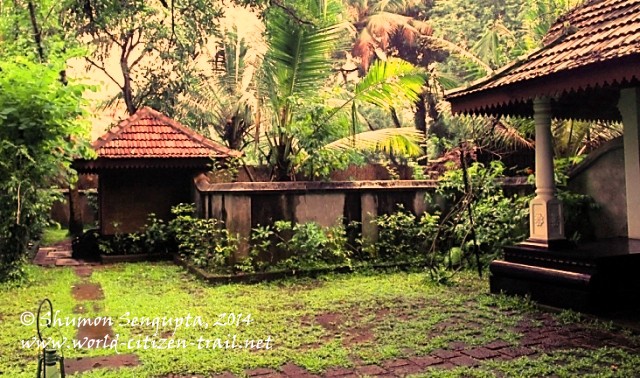
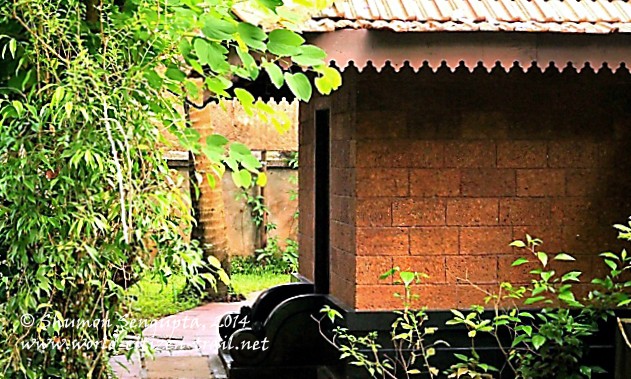
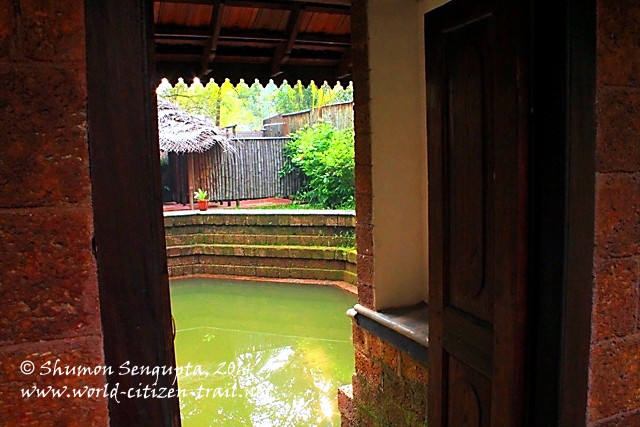
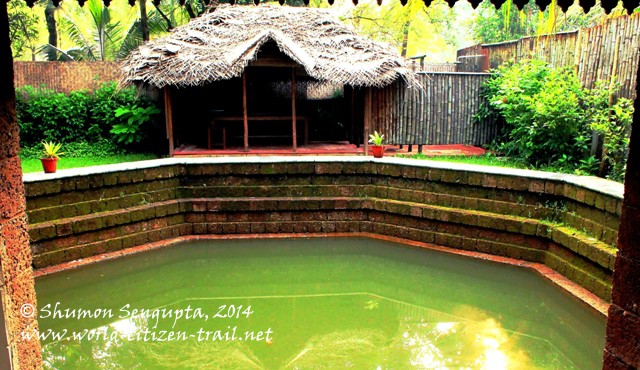
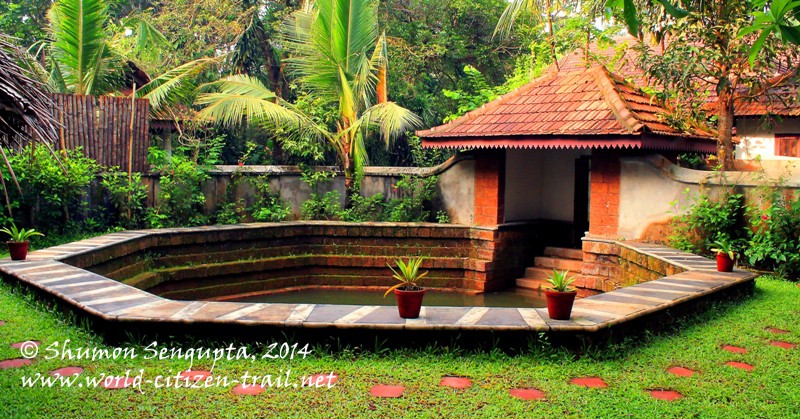
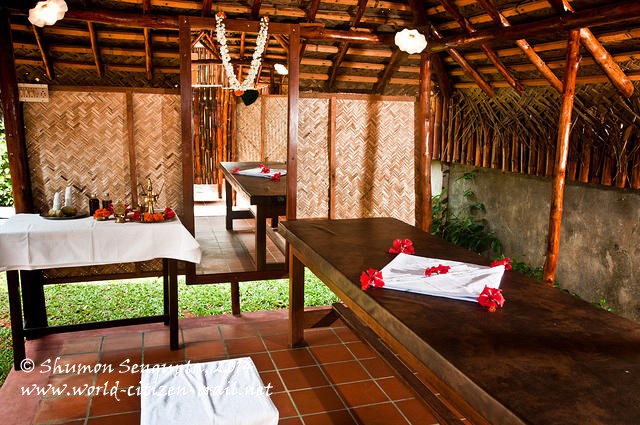
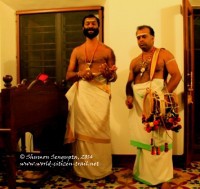 On our first evening, we had two temple priests from the adjoining Shri. Krishna temple, who came over and sang some melodious devotional songs called Sopana Sangeetham, rendered in, what I gathered was a form of highly sanskritized Malayalayam, to the accompaniment of the flat temple gong and a curious temple percussion instrument called the ‘Edakka’. Although we did not understand the lyrics, we enjoyed the experience.
On our first evening, we had two temple priests from the adjoining Shri. Krishna temple, who came over and sang some melodious devotional songs called Sopana Sangeetham, rendered in, what I gathered was a form of highly sanskritized Malayalayam, to the accompaniment of the flat temple gong and a curious temple percussion instrument called the ‘Edakka’. Although we did not understand the lyrics, we enjoyed the experience.
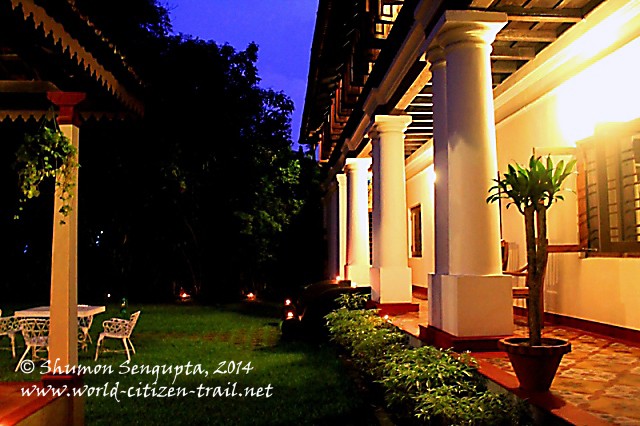
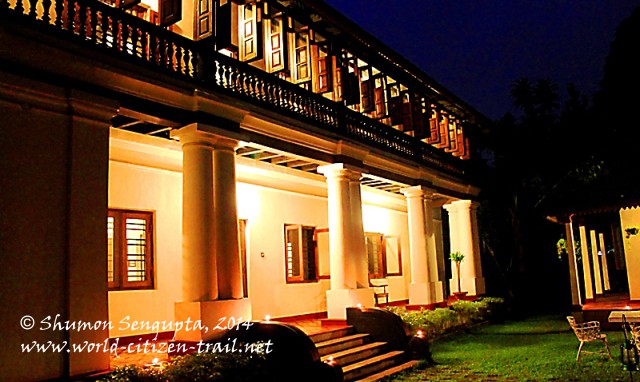

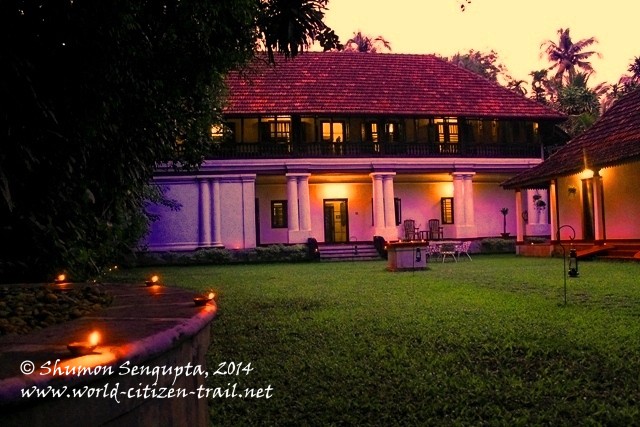
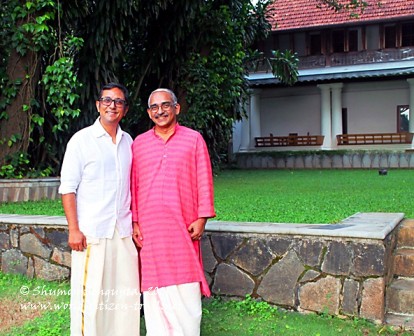 On the afternoon of our second day at Chittoor Kottaram, we had a special visitor. I had requested a meeting with Mr. Suresh Namboodri, a member the Kochi Royal family and owner of the place and he came over for a chat. I was in particular curious to learn about the history of the Chittoor Kottaram.
On the afternoon of our second day at Chittoor Kottaram, we had a special visitor. I had requested a meeting with Mr. Suresh Namboodri, a member the Kochi Royal family and owner of the place and he came over for a chat. I was in particular curious to learn about the history of the Chittoor Kottaram. 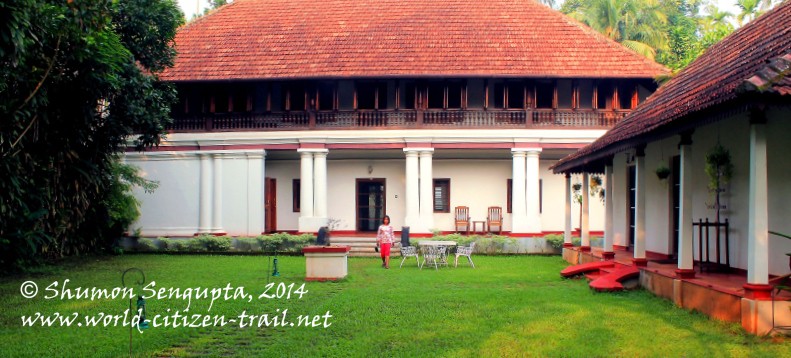
 I must mention the extraordinary food we had at Chittoor Kottaram. Because Chittoor Kottram used to be a spiritual retreat of the Maharajah of Kochi, food served is strictly lacto-vegetarian. The menu is fixed and you don’t have a choice. But what is in offer is outstanding, to say the least.
I must mention the extraordinary food we had at Chittoor Kottaram. Because Chittoor Kottram used to be a spiritual retreat of the Maharajah of Kochi, food served is strictly lacto-vegetarian. The menu is fixed and you don’t have a choice. But what is in offer is outstanding, to say the least.
While breakfast, lunch and dinner were served in the pavilion in the garden, tea, coffee and refreshments were served in the room or in any of the beautiful niches in the property we chose for the purpose.
Breakfast included a selection fresh fruit juice, cut fruit, followed by traditional Kerala breakfast of Idly, or Dosai. There were also different kinds of traditional steamed rice cakes, as well as steamed plantain with fresh grated coconut and honey. There was cereal, milk, nuts and raisins if you wanted a continental breakfast.
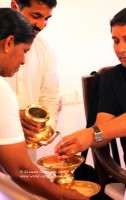 Lunch was an elaborate affair and before it was served, Milton insisted on pouring the water from a brass pot to wash our already washed hands, like it used to be done for the Maharajah of Kochi in the past.
Lunch was an elaborate affair and before it was served, Milton insisted on pouring the water from a brass pot to wash our already washed hands, like it used to be done for the Maharajah of Kochi in the past.
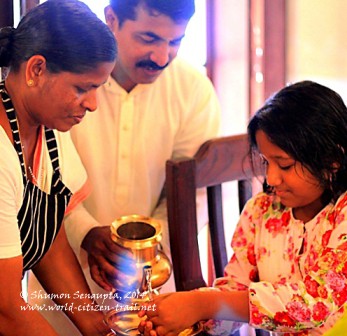 Annie, the chef, had conjured an amazing 10-item traditional Kerala vegetarian feast called the ‘Sadya’, made with the finest supplies of fresh vegetables, pulses, grains, coconut, milk/yogurt, herbs, spices and condiments and with very little coconut oil. The entire spread was served on a large piece of a banana leaf in one go, before we could started eating. Our meal was rounded off with a helping of the rich and delicious ‘parippu payasayam’ – the Kerala style pudding. The meal was a manna from the heavens.
Annie, the chef, had conjured an amazing 10-item traditional Kerala vegetarian feast called the ‘Sadya’, made with the finest supplies of fresh vegetables, pulses, grains, coconut, milk/yogurt, herbs, spices and condiments and with very little coconut oil. The entire spread was served on a large piece of a banana leaf in one go, before we could started eating. Our meal was rounded off with a helping of the rich and delicious ‘parippu payasayam’ – the Kerala style pudding. The meal was a manna from the heavens.
Dinner was more or less a fusion of north and south Indian vegetarian food served in silverware. Seeing my enthusiasm for food, Annie invited me to observe her conjuring up culinary magic in her kitchen the next morning. I did that with great pleasure. 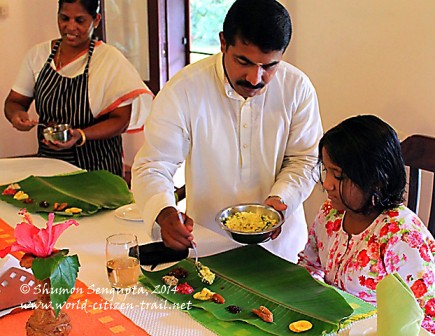
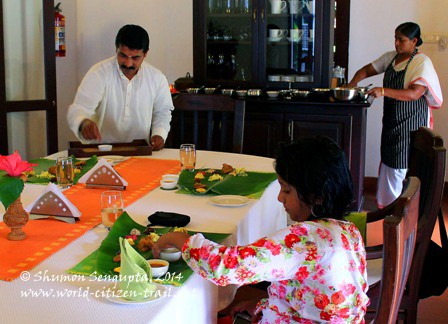
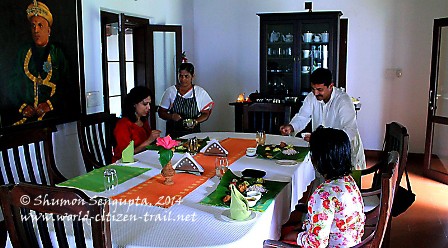
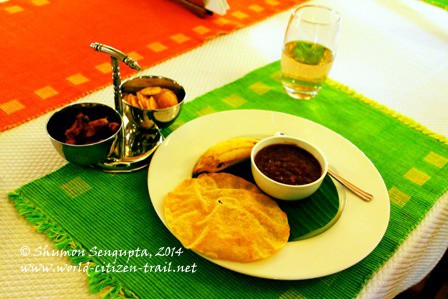
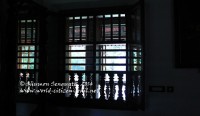 At Chittoor Kottaram, during the two days and nights we spent there, we woke up to the sound of distant temple bells and the birdcall and took the day as it presented itself. We did practically nothing and time seemed to be in a standstill. In the languid afternoons we spent hours at the hammock or at the gazebo, reading a book or simply doing nothing.
At Chittoor Kottaram, during the two days and nights we spent there, we woke up to the sound of distant temple bells and the birdcall and took the day as it presented itself. We did practically nothing and time seemed to be in a standstill. In the languid afternoons we spent hours at the hammock or at the gazebo, reading a book or simply doing nothing.
The wetlands around seemed to be host to an amazing variety of bird life. We spotted two splendid Brahmini Kites with their white heads and breasts and rich deep brown wings in full span swoop high up in the sky and then majestically glide downward and sideways in broad sweeps. It seemed they were having a great time and we enjoyed their aerial acrobatics display immensely. And then there was the awesome stork billed Kingfisher (with its brilliant blue wings, yellow neck and a red beak) taking sharp dives towards the water and snapping up fish. A few Pond Herons were also to be sighted either in flight or perched on the floating water hyacinth.
 And then Minnie (who is an avid bird watcher at her boarding school in Rishi Valley) pointed out the group of little Bee Eaters, little purple Sunbirds, Bulbul and the Black Drongo, the last one with its forked tail. Of course there were many Cormorants – flying, frolicking on water, taking dives into the water in search of fish or simply perched on tree stumps, flapping and drying their wings, airing themselves and generally having a good time. I could easily recognize the Cormorants.
And then Minnie (who is an avid bird watcher at her boarding school in Rishi Valley) pointed out the group of little Bee Eaters, little purple Sunbirds, Bulbul and the Black Drongo, the last one with its forked tail. Of course there were many Cormorants – flying, frolicking on water, taking dives into the water in search of fish or simply perched on tree stumps, flapping and drying their wings, airing themselves and generally having a good time. I could easily recognize the Cormorants.
The afternoons were incredibly beautiful and spent in solitude; all worries and worldly cares were set aside for the time being. We had the company of birds and the bird calls and the occasional rustle and murmur of the leaves in the monsoon wind, for music.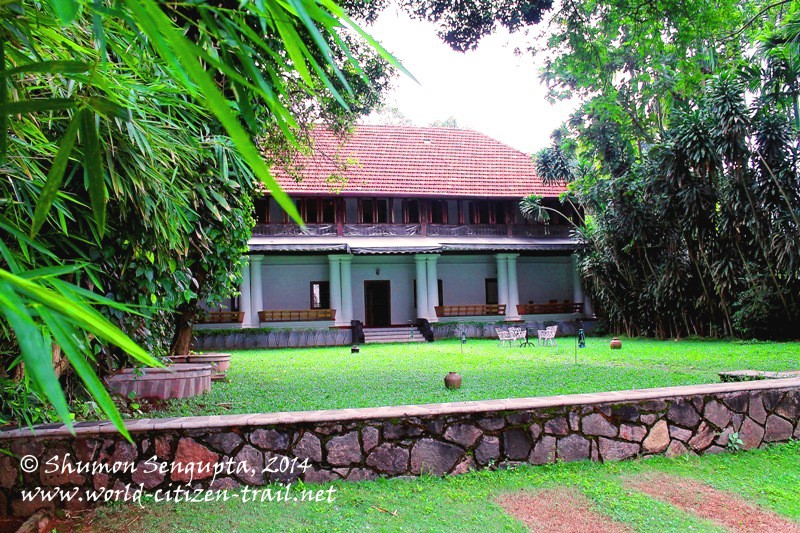
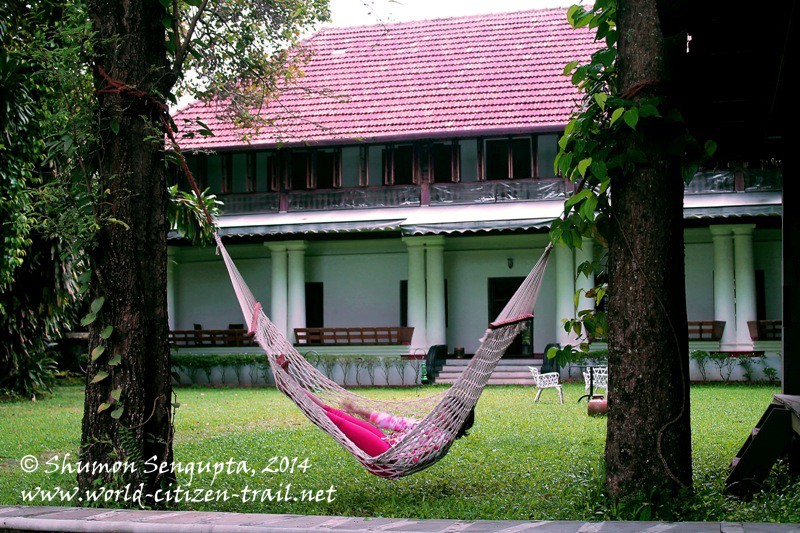
On our second afternoon, we took an evening cruise of the surrounding lagoons, backwaters and the Periyar estuary in Chittoor Kottaram’s little launch.
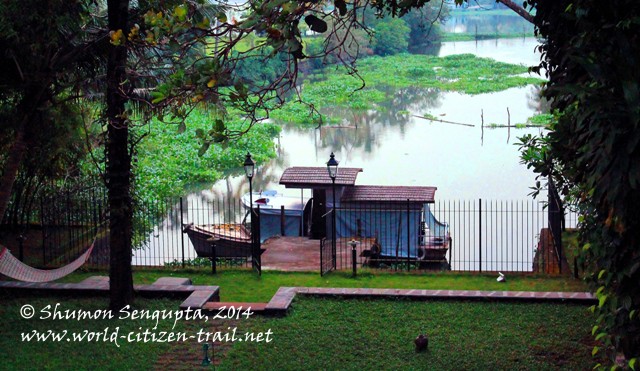
 As the sun set, in gradually fading daylight we went past little islands, little villages by the banks with children returning home late from school, people winding up work for the day, the last supplies of the day being ferried in little boats, coconut grooves, paddy fields, temples, churches and little shrines, and the big Chinese fishing nets with its spider web like nets. One of the churches we went past had its own private jetty and from our boat, we could see an evening service in progress. It was a complete tableau of life by the waters and nature in full splendor.
As the sun set, in gradually fading daylight we went past little islands, little villages by the banks with children returning home late from school, people winding up work for the day, the last supplies of the day being ferried in little boats, coconut grooves, paddy fields, temples, churches and little shrines, and the big Chinese fishing nets with its spider web like nets. One of the churches we went past had its own private jetty and from our boat, we could see an evening service in progress. It was a complete tableau of life by the waters and nature in full splendor.
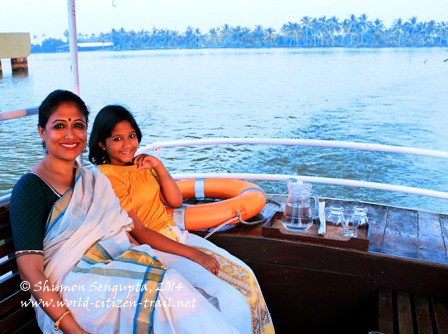 The ringing of temple bells and music from the temples came floating over the waters as everything was bathed first in molten silver of the late afternoon sun and then in a golden glow of the setting sun. From afar, we could also hear the Azan – the melodious call for Muslim prayers. Birds were returning to their nests, as were fishermen in their little boats, as day gave way to the twilight.
The ringing of temple bells and music from the temples came floating over the waters as everything was bathed first in molten silver of the late afternoon sun and then in a golden glow of the setting sun. From afar, we could also hear the Azan – the melodious call for Muslim prayers. Birds were returning to their nests, as were fishermen in their little boats, as day gave way to the twilight.
After our sunset cruise in the lagoon, we came back and witnessed a scintillating performance of Bharatnatyam – the old classical dance form of South India, performed by a young and talented danseuse.
If our days were spent in languor and solitude amidst the call of the birds and the occasional murmur of the leaves in the monsoon breeze, the evenings and nights were shrouded in a sense of mystery and magic.
In the evenings, Milton and Jithin lit numerous earthen lamps and placed them all along the garden and the verandas. The sense of uncertainty and psychological tension that is generally associated with the darkness of the tropics was dispelled by the sheer beauty we beheld, giving way to a sense of serenity and joy. These little lamps studded the tropical night with the soft warm glow of their dancing flames, setting into motion the play of a thousand mysterious shadows.
Time seemed to have come to a standstill at Chittoor Kottaram. Amidst such poignant beauty, peace and the tender stillness of nature, our inner selves mirrored the tranquility of our surroundings. If one could live in magic, it was right there.
*****************************************************************
